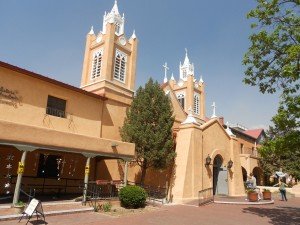Old Town Albuquerque New Mexico is very representative of most of the Spanish settlements in the southwest United States. The most distinguishing characteristic is the town plaza. Old Town Albuquerque resides in about ten blocks filled with adobe structures. Today it is a very popular tourist destination with a wide assortment of shops, unique art galleries and restaurants. Old Town is the Historical Zone of the City of Albuquerque and home for many families whose ancestors founded the town. On the banks of the Rio Grande, Old Town Albuquerque has thrived for three centuries. Vacations in New Mexico offer many alternatives. If you’re searching for things to do in Albuquerque, the Old Town Historic District is a great choice.
Thank you for reading this post, don't forget to subscribe!
The plaza didn’t come into being until 1780. Prior to that the Albuquerque area was a scattered agricultural area. The plaza appeared after settlers built adobe homes around a defensible center for protection against the Comanche and Apache Indian attacks. The defensible area became what is now the plaza. Prior to that, the fortress would have been the church.
Everything pertaining to Spain in the southwest first occurred when Francisco Vasquez Coronado explored this area in 1540.The region was inhabited by a combination of Pueblo Indians and the nomadic Apaches and Comanches. It would be about 60 years later that the Spaniards started to settle and colonize the region. It would be about another one hundred years before Albuquerque was officially founded.
For almost three centuries Old Town has been the crossroads of the Southwest. On the north side of the plaza, which is the focal point of Old Town, is the San Felipe de Neri Church, the oldest building in the city, which was built in 1793. The church was first named San Francisco Xavier by Don Francisco Cuervo y Valdez, who founded the city of Albuquerque in 1706. Valdez named the church after the Viceroy of New Spain. Later, the Duke of Albuquerque ordered that the titular saint for the church be changed to San Felipe de Neri in honor of King Philip of Spain. The original church on the site was founded back in 1706, at the time of original settlement, by Franciscan priest Manuel Moreno.

This church however collapsed in 1792 due to very heavy rains. The new church was built in 1793 and is the one that stands there today. When you visit the church you’ll also see the beautiful gardens in the front facing the plaza.
Everything for the church changed in 1821 after Mexico won it’s independence from Spain. Mexico ordered the Franciscan priests to leave which was happening throughout the old Spanish territories. Later in 1853, after the United States took possession of New Mexico Territory, a French priest, Father Joseph Machebeuf, was named pastor of Albuquerque by Bishop Lamy of Santa Fe. At this same time the church was remodeled which included a new roof. It’s a very beautiful structure.
It’s interesting to note that the El Camino Real de Tierra Adentro, the Royal Road of the Interior Nuevo Mexico territory, which connected Mexico City with New Mexico’s Spanish capitals ran right through Old Town Albuquerque. The capitals were San Gabriel and then later Santa Fe. This was the main route to the new Spanish territory for all commerce until the Santa Fe Trail from Missouri was established in 1821. The U.S. government has now designated the El Camino Real a National Historic Trail. This amazingly long trail from Mexico City went back to the year 1598, about a decade before the founding of Santa Fe.

Several flags have flown over the Old Town Albuquerque plaza. First it was Spain’s, then Mexico’s beginning in 1821 and then it was the United States flag beginning in 1846. The only interruption with the United States flag from 1846 to today was a thirty-nine day period during the American Civil War when General Henry Sibley’s Texas Volunteer regiment flew the Confederate flag over the plaza. General Sibley would go on to be defeated later by Colorado Volunteers at the Battle of Glorieta Pass which is just to the east of Santa Fe. During the Civil War, southern forces made large inroads into the southern section of the New Mexico Territory. There are two Mountain Howitzer guns that are on display today on the plaza. Both guns were left behind by retreating Confederate troops.
The move east to New Town, downtown today, occurred in 1880 and was a direct result of the Atchison Topeka & Santa Fe Railroad coming into Albuquerque. Eventually there was a Harvey House, named the Alvarado, at the site of today’s train terminals. Unfortunately, the Alvarado was torn down in 1970.
The Albuquerque Museum of Art and History is located at 2000 Mountain Road. This is about 1,000 feet east of the plaza itself. Included in the museum are traveling exhibits, southwestern art, Albuquerque history artifacts and outside is a sculpture garden. You’ll also want to check out Old Town area B & B’s and hotels. There’s a great choice.
Old Town Albuquerque is located about two miles west of the City of Albuquerque downtown area. Of special note, is that Old Town Albuquerque can be reached rather easily from the Santa Fe area by riding the New Mexico Rail Runner train. The NM Rail Runner will take you to the train station in downtown Albuquerque and your train ticket will get you a free bus ride to and from Old Town. It’s a good way to fit in a trip to Albuquerque while visiting Santa Fe.
(Photos from author’s private collection)
